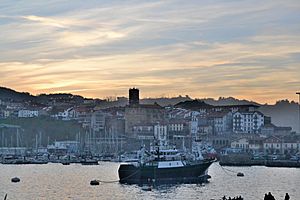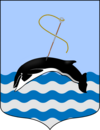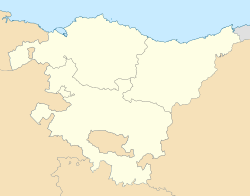Getaria, Spain facts for kids
Getaria is a town located on the coast of the Basque Country in northern Spain. It's part of the Gipuzkoa province and sits between the towns of Zarautz and Zumaia.
This charming town is famous for being the birthplace of Juan Sebastián Elcano. He was an amazing sailor who became the first person to sail all the way around the world! Elcano was the captain of the Nao Victoria, the only ship from Magellan's fleet to complete the incredible journey.
Today, Getaria is also well-known for its delicious grilled fish restaurants and a special white wine called Txakoli, which has its own Denomination of Origin. You can also visit the Cristobal Balenciaga Museum here. In 2012, a team from Getaria even won a Google competition for creating a full 3D model of their hometown!
Quick facts for kids
Getaria
|
||
|---|---|---|

Getaria view from the sea
|
||
|
||
| Country | ||
| Autonomous community | ||
| Province | Gipuzkoa | |
| Comarca | Urola Kosta | |
| Area | ||
| • Total | 10.6 km2 (4.1 sq mi) | |
| Population
(2018)
|
||
| • Total | 2,818 | |
| • Density | 265.8/km2 (689/sq mi) | |
| Time zone | UTC+1 (CET) | |
| • Summer (DST) | UTC+2 (CEST) | |
| Postal code |
20808
|
|
| Area code(s) | 34 (Spain) + 943 (Gipuzkoa) | |
Contents
What's in a Name? The Story of Getaria
The name of this town has an interesting history. For a long time, it was written as Guetaria. But since 1980, the official spelling has been Getaria, which fits with modern Basque writing. Even though it's spelled differently, it's pronounced the same way in both Spanish and Basque.
Ancient Roots of the Name
There's another town called Guéthary (or Getaria in Basque) about 61 kilometers away in the French Basque Country. Both towns are on the coast, and people have wondered for a long time where their names came from.
One strong idea is that the name Getaria comes from the Latin word "cetaria." This word means "a place where fish is preserved." This makes sense because archaeologists have found signs of old Roman fish canneries in both Getaria towns!
A Lookout Point?
Another idea for the name comes from the Gascon language. The Gascon word "guaita" means "lookout." During the Middle Ages, people from Gascony settled in many villages along the Basque coast, including both Getarias.
Some think Getaria might be a mix of "guaita" and "-ari," a Basque ending used for professions, meaning "watchman." So, it could mean "watchman's place." Others believe it's a mix of "guaita" and "-erri," which means "town," making it "the town of the watchman."
Getaria's Unique Geography
Getaria is located on the central coast of Gipuzkoa, right by the Cantabrian Sea. This part of the coast has steep cliffs, where the ocean has carved out many coves and points.
The Mouse of Getaria
The oldest part of Getaria town sits between the mainland and a mountain called San Antón. This mountain is famously known as the "Mouse of Getaria" because of its shape! It looks just like a mouse. What's even cooler is that this mountain used to be an island until the 16th century.
Inland Beauty
Further inland, you'll find Mount Garate, which is 278 meters tall. It runs alongside the coast. On its gentle slopes, there are many traditional Basque farms called baserri.
Most of the land between Mount Garate and the coast is covered in vineyards. This area has a special microclimate that's perfect for growing grapes, especially for the local Txakoli wine.
A Glimpse into Getaria's Past
Getaria has a long and interesting history, possibly even dating back to Roman times.
Founding in the Middle Ages
The town of Getaria was officially founded between 1180 and 1194 by King Sancho VI of Navarre. This makes it one of the oldest towns in the province, just like San Sebastián.
Later, in 1209, King Alfonso VIII of Castile confirmed Getaria's special rights, called a Fuero. This showed that Getaria was an important town.
Special Privileges
Throughout its history, Getaria enjoyed many special rights and benefits. Here are a few examples:
- 1270: The town was allowed to cut all the wood they needed from Gipuzkoa to build their homes and ships.
- 1290: People from Getaria didn't have to pay tolls or other taxes in the Kingdom of Castile and Leon.
- 1407: Ships bringing wheat and other grains to the town's port had to unload half of their cargo there.
Whaling and the Port
In the 15th century, the space between the island of San Antón (the "Mouse") and the town was filled in. This helped create the port. Getaria's port was traditionally used for whaling. In fact, the last whale caught in nearby waters was brought to this port in 1878 by fishermen from Getaria and Zarautz. Today, it's still a very important port on the Basque coast.
The Thirty Years' War
In 1638, during the Thirty Years' War, a French fleet attacked Getaria. The French wanted to use Getaria's port to help them attack the nearby town of Hondarribia.
On July 24, 1638, the French attacked the Spanish fleet in Getaria. Most of the Spanish ships were destroyed. However, when the French tried to take the town, the people of Getaria and Zarautz, along with help from other towns, fought them off. The town was badly damaged by French cannons, but no French soldiers managed to get inside its walls.
Later Conflicts
Getaria also faced challenges during other wars:
- Peninsular War (1811-1813): French troops occupied Getaria, causing a lot of damage before they left.
- Carlist Wars (1835-1836): The town was almost completely destroyed again. After being surrounded by Carlist forces, it was captured and set on fire. Only a few houses remained, badly damaged. Even the main church needed major repairs.
Getaria's Economy
Getaria's main ways of making money today are fishing, tourism, and growing grapes for Txakoli wine.
In the early 1800s, people in Getaria focused more on farming than fishing. They produced some of the best Txakoli wine in Gipuzkoa. While Txakoli is still made today, fishing became the main source of income for a long time. However, fishing is now becoming less common.
Cider is also produced in some of the nearby areas like Askizu, Akerregi, and Meagas.
Local Government
Getaria is governed by a local council. Here's a look at how the votes were cast in some past elections:
| Political party | 2011 | 2007 | ||
|---|---|---|---|---|
| Votes % | Councillors | Votes % | Councillors | |
| Bildu | 46,67% | 5 | - | - |
| Partido Nacionalista Vasco (EAJ-PNV) | 40,46% | 5 | 62,31% | 8 |
| Aralar | 9,57% | 1 | 23,04% | 2 |
| Eusko Alkartasuna (EA) | - | - | 7,93% | 1 |
See also
 In Spanish: Guetaria para niños
In Spanish: Guetaria para niños




